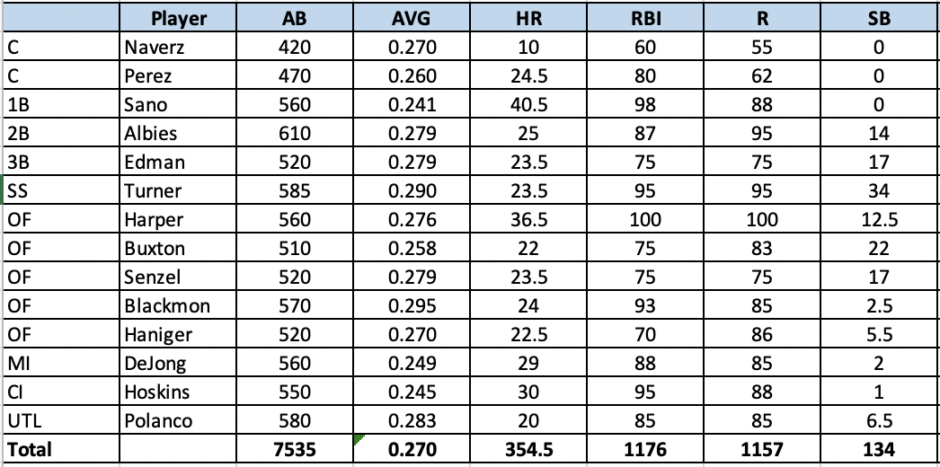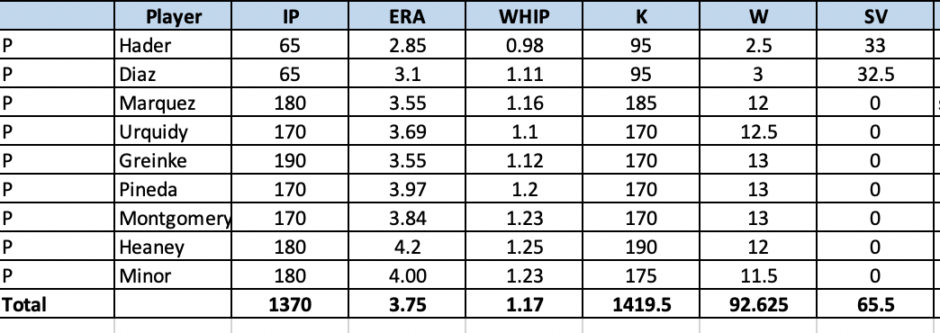This year I’m only doing one draft. Usually I two or three, but since I’m building a new house, I decided keeping extra cash was the most prudent thing to do. I’ve won at least one league in the past two seasons (I’m excluding 2020) and I think I’m going to win for a third year in a row.
League Background
This is a 12-team mixed NFBC draft. The roster consists of 14 hitters, nine pitchers and seven bench players. You set your pitchers once a week; hitters are set twice a week; waivers occur once a week.
Overall Thoughts
I never saw so much starting pitching taking in the first 2-3 rounds. Nine pitchers were taken in the first two rounds (37.5% of the picks) and 15 pitchers taken in the first three rounds (41.7% of the picks).
I think the rationale for the premium on pitching is if most, if not all, pitchers will have lower workloads then it’s better to get as many quality innings as possible. For example, in a normal year for fantasy a pitching staff may have 1,400 innings. But if workloads are decreased maybe there will only be 1,300 innings. If so, then those 180 innings of Jacob DeGrom will even more valuable because his innings represent a bigger part of the total.
That could be true, but I think in order to win you have to do A) do something different from the crowd and B) have your actions be correct. In other words, you want to be a contrarian, but you don’t want to be contrarian just to be contrarian.
My thesis was I want to stream pitchers all year because innings are going to be scarce. So, my plan was I wanted to dedicate five out of the seven bench spots to starting pitchers. To achieve this, I had to spend a lot of my early picks on hitters and I wanted to get two closers who should keep the job all year.
Lastly, in rounds 4-6 there were only six starting pitchers and three relievers taken. In those rounds owners were drafting hitting but I drafted two relievers and one hitter.
My Team
Below is my team with my projections; not listed are my bench players but they will be discussed below the images:


Individual Player Analysis
Trea Turner (#2) – Originally, I was going to take Fernando Tatis Jr. at the second spot, but there wasn’t that much difference between Tatis and Turner. Stolen bases will be scarce this year and that is the one edge Turner had. Also, Turner has a better health history.
Bryce Harper (#23) – With all the pitching taken Harper fell to me. When I was planning my draft I didn’t even consider him being available. I projected 12.5 stolen bases; I wouldn’t be shocked if he only steals 5-6.
Ozzie Albies (#26) – Albies was my top rated second baseman. I had Xander Bogaerts rated higher, but I already had a shortstop and I knew I was going to draft Paul DeJong later so I took the best player available that wasn’t a shortstop. For my projections I assumed Albies would hit second. There was chatter that Dansby Swanson would hit second, but that’s crazy talk. Swanson is a good real life player but he’s not the hitter Albies is.
Josh Hader (#47) & Edwin Diaz (#50) – Liam Hendricks was top closer but he was off the board so I took the top two closers remaining. My thesis for taking two closers is I get guaranteed saves with good ratios and a lot of strikeouts. There is risk with both pitchers; Hader will only pitch one inning, which reduces his strikeouts and Diaz may lose his job. Diaz walks too many guys and when men get on base for free bad things happen. In his last 84 innings he has a .379 BABIP. I have to assume the BABIP regresses and he has a high two’s/low three’s ERA with plenty of strikeouts.
The idea for drafting two legit closers was I wouldn’t have to use bench spots on potential closers and I wouldn’t have to use a lot of my FAAB on closers throughout the year. Lastly, if innings are less overall then the good ratios of the closers will be even more useful.
Sal Perez (#71) – You have to start two catchers and with the position being so bad, getting a top catcher is even more important. In the NFBC format you don’t want to wait for catching. For example, the worst catcher is far worse than the worst second baseman. You’re betting off paying for a top catcher and getting the other positions later on.
Byron Buxton (#74) – If he can play a full year he easily gets to 20/20. If he has a breakout he’s a 30/30 player.
Charlie Blackmon (#95) – I planned on taking Wil Myers in this spot but he wasn’t available. Blackmon biggest asset is the batting average. He will easily hit in the .290’s and could hit in the .300’s. He’s not going to steal bases but I’m not counting on him for that.
Tommy Edman (#98) – The biggest worry I had for Edman was Matt Carpenter taking at-bats from Edman. Well, Carpenter looks done and with Harrison Bader out Edman is going to play every day in the leadoff position. In 147 games Edman is hitting .283 with 16 home runs and 17 stolen bases. A lot of fantasy experts are down on Edman, but according to my data it’s not unreasonable he goes 20/20. Also, he has eligibility at four positions. That position flexibility will allow me more bench space for pitchers.
Nick Senzel (#119) – this is a purely a bet on Senzel’s raw talent and that the Reds hopefully leave him alone and let him play every day.
Miguel Sano (#122) – It seems like I draft him every year. Joey Gallo gets all the fantasy headlines but Sano has more power than Gallo. The new baseball this year won’t alter Sano’s power potential.
Zack Greinke (#143) – At this price point I’m not expecting him to be a top ten pitcher. He was 19th on my board and at this price I think I got a steal. It’s also possible the decline in fastball velocity makes him ordinary. Again, at the price I paid I think Greinke is worth it.
Jose Urquidy (#146) – This pick is purely on the raw stuff and the hope that being on a good team he can get more wins than if he were on a bad team.
Rhys Hoskins (#167) – Hoskins is not a good defensive first baseman but for fantasy that doesn’t matter. He’s going to hit fourth every day with a lot of power. His batting average will be low but that’s why I drafted someone like Blackmon.
Paul DeJong (#170) – How many shortstops can hit 25-30 home runs with a lot of RBI potential? Not that many. DeJong is a steal at this price.
Mitch Haniger (#191) – I’m hoping Haniger is finally healthy and can play in 150 games.
Jorge Polanco (#194) – Polanco will get second base eligibility after two weeks. Roster Resource has him batting fourth in a very good lineup. He does a little bit of everything. I projected a .283 batting average but I can easily see a .295 average. Also, if he drops to 5th in the lineup; I have Sano so either way I’m getting the 4th spot in the Twins batting order.
German Marquez (#215) – For my projections I assumed that all his starts would be on the road. As long as I stream Marquez I’ll get a lot of value. Also, it’s possible he’s traded which makes him even more valuable. The only downside is he probably won’t get a lot of wins because the bullpen being so bad.
Omar Navarez (#218) – I waited to get my second catcher because Navarez was my 11th rated catcher and he was going as the 20th catcher. I drafted him because of playing time and his batting average; a career .267; and he’s two years removed from 22 home runs.
Michael Pineda (#239) – Pineda is more of an accumulator at this point. He should provide a lot of innings with solid strikeouts, WHIP and hopefully wins. His stuff is good enough he could be a number two real life starter.
Kyle Schwarber (#242) – I was planning on taking a pitcher here but I couldn’t believe Schwarber was still available. Yes, he’s not a good defender and he doesn’t hit for average. But he has the power to hit 30-plus home runs and if someone gets hurt I can plug him in and still get my power. Also, he should hit fourth or fifth which means he’ll get a lot of RBIs.
Jordan Montgomery (#263) – see Michael Pineda.
Andrew Heaney (#266) – This is a bet purely on his stuff. If he takes the next step, he’s a real life number two starter.
Mike Minor (#287) – This is a bet purely on his stuff.
Eduardo Escobar (#290) – Escobar is always underrated. He’s going to hit fourth in the lineup and hit 20-25 home runs with a lot of RBI and a batting average that won’t hurt you. Also, I didn’t have another third baseman so I wanted to make sure I had a solid backup.
Mitch Keller (#311) – This is a bet purely on his stuff.
Anthony DeSclafani (#314) – For my projections I assumed all of his innings would be pitched at home. If I only stream him at home he should be a good backend starter.
Trevor May (#335) – May is a hedge for my Diaz pick.
Chris Archer (#338) – Curious to see how he looks.
Luke Weaver (#359) – Curious to see how he looks.
Conclusion
Overall, I love my team. It’s far from perfect but I hit (pun intended) all my hitting thresholds and I have a pitching staff that if mixed and matched correctly and luckily, I should have a mediocre pitching staff.



